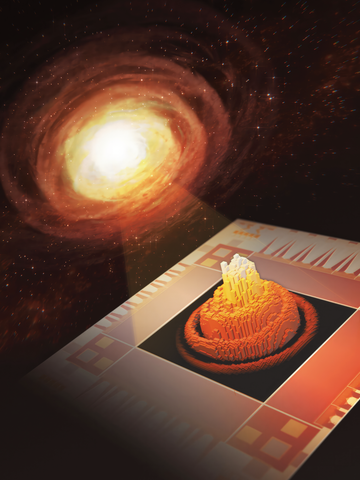NIST Team Develops Highest-Resolution Single-Photon Superconducting Camera
Having more pixels could advance everything from biomedical imaging to astronomical observations.

With planned improvements, NIST’s new 400,000 single-wire superconducting camera, the highest resolution camera of its type, will have the capability to capture astronomical images under extremely low-light-level conditions.
Researchers at the National Institute of Standards and Technology (NIST) and their colleagues have built a superconducting camera containing 400,000 pixels — 400 times more than any other device of its type.
Superconducting cameras allow scientists to capture very weak light signals, whether from distant objects in space or parts of the human brain. Having more pixels could open up many new applications in science and biomedical research.
The NIST camera is made up of grids of ultrathin electrical wires, cooled to near absolute zero, in which current moves with no resistance until a wire is struck by a photon. In these superconducting-nanowire cameras, the energy imparted by even a single photon can be detected because it shuts down the superconductivity at a particular location (pixel) on the grid. Combining all the locations and intensities of all the photons makes up an image.
The first superconducting cameras capable of detecting single photons were developed more than 20 years ago. Since then, the devices have contained no more than a few thousand pixels — too limited for most applications.
Creating a superconducting camera with a much greater number of pixels has posed a serious challenge because it would become all but impossible to connect every single chilled pixel among many thousands to its own readout wire. The challenge stems from the fact that each of the camera’s superconducting components must be cooled to ultralow temperatures to function properly, and individually connecting every pixel among hundreds of thousands to the cooling system would be virtually impossible.
NIST researchers Adam McCaughan and Bakhrom Oripov and their collaborators at NASA’s Jet Propulsion Laboratory in Pasadena, California, and the University of Colorado Boulder overcame that obstacle by combining the signals from many pixels onto just a few room-temperature readout wires.
A general property of any superconducting wire is that it allows current to flow freely up to a certain maximum “critical” current. To take advantage of that behavior, the researchers applied a current just below the maximum to the sensors. Under that condition, if even a single photon strikes a pixel, it destroys the superconductivity. The current is no longer able to flow without resistance through the nanowire and is instead shunted to a small resistive heating element connected to each pixel. The shunted current creates an electrical signal that can rapidly be detected.
Borrowing from existing technology, the NIST team constructed the camera to have intersecting arrays of superconducting nanowires that form multiple rows and columns, like those in a tic-tac-toe game. Each pixel — a tiny region centered on the point where individual vertical and horizontal nanowires cross — is uniquely defined by the row and column in which it lies.
That arrangement enabled the team to measure the signals coming from an entire row or column of pixels at a time rather than recording data from each individual pixel, drastically reducing the number of readout wires. To do so, the researchers placed a superconducting readout wire parallel to but not touching the rows of pixels, and another wire parallel to but not touching the columns.
Consider just the superconducting readout wire parallel to the rows. When a photon strikes a pixel, the current shunted into the resistive heating element warms a small part of the readout wire, creating a tiny hotspot. The hotspot, in turn, generates two voltage pulses traveling in opposite directions along the readout wire, which are recorded by detectors at either end. The difference in time it takes for the pulses to arrive at the end detectors reveals the column in which the pixel resides. A second superconducting readout wire that lies parallel to the columns serves a similar function.
The detectors can discern differences in arrival time of signals as short as 50 trillionths of a second. They can also count up to 100,000 photons a second striking the grid.
Once the team adopted the new readout architecture, Oripov made rapid progress in increasing the number of pixels. Over a matter of weeks, the number jumped from 20,000 to 400,000 pixels. The readout technology can easily be scaled up for even larger cameras, said McCaughan, and a superconducting single-photon camera with tens or hundreds of millions of pixels could soon be available.
Over the next year, the team plans to improve the sensitivity of the prototype camera so that it can capture virtually every incoming photon. That will enable the camera to tackle such low-light endeavors as imaging faint galaxies or planets that lie beyond the solar system, measuring light in photon-based quantum computers, and contributing to biomedical studies that use near-infrared light to peer into human tissue.
The researchers reported their work in the Oct. 26 edition of Nature (https://www.nature.com/articles/s41586-023-06550-2).
On May 7, 2024, the NASA science webpage published an article on the superconducting camera and its potential applications in the search for planets outside our solar system. Read the article at nasa.gov.
Paper: B.G. Oripov, D.S. Rampini, B. Korzh, J. Allmaras, M.D. Shaw, S.W. Nam and A.N. McCaughan. A superconducting-nanowire single-photon camera with 400,000 pixels. Nature. Oct. 26, 2023. https://doi.org/10.1038/s41586-023-06550-2

